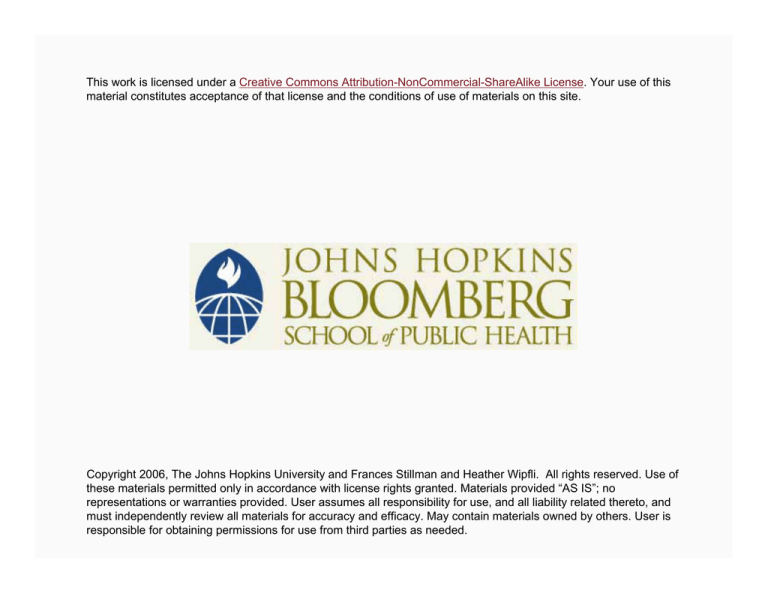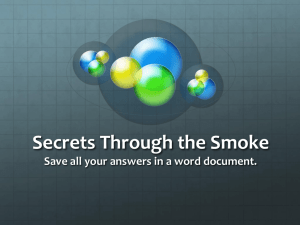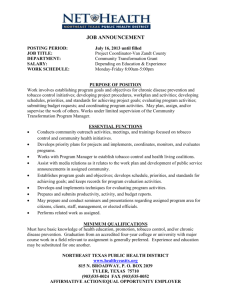
This work is licensed under a Creative Commons Attribution-NonCommercial-ShareAlike License. Your use of this
material constitutes acceptance of that license and the conditions of use of materials on this site.
Copyright 2006, The Johns Hopkins University and Frances Stillman and Heather Wipfli. All rights reserved. Use of
these materials permitted only in accordance with license rights granted. Materials provided “AS IS”; no
representations or warranties provided. User assumes all responsibility for use, and all liability related thereto, and
must independently review all materials for accuracy and efficacy. May contain materials owned by others. User is
responsible for obtaining permissions for use from third parties as needed.
The Framework Convention on Tobacco
Control (FCTC)
Frances Stillman, EdD, and Heather Wipfli, MA
Institute for Global Tobacco Control
Johns Hopkins Bloomberg School of Public Health
Global Tobacco Use
Approximately 1.1 billion people smoke—
significantly higher proportion of men than women
82% reside in low- and middle-income countries
Approximately 70% of 10 million tobacco-attributable
deaths expected in 2030 will take place in low- and
middle-income countries
Spread by international trade, advertising, promotion,
and smuggling
3
Section A
The Framework Convention on Tobacco Control
What Is a Framework Convention?
A binding international legal instrument which
establishes broad commitments and a general system
of governance for an issue area
Specific measures designed to implement goals of the
framework convention or further institutional
commitments made through protocols
Example: Framework Convention on Climate Change
(Kyoto Protocol)
5
What Is the FCTC?
Global evidence-based treaty designed to
circumscribe the global rise and spread of the tobacco
epidemic
− Addresses secondhand smoke protections,
tobacco taxation, tobacco product regulation,
cigarette smuggling, public education, and
cessation treatment
Continued
6
What Is the FCTC?
First time WHO member states have harnessed the
organization’s capacity to develop a binding
international convention to protect and promote
global public health
First time that low-, medium-, and high-income
countries have united to develop a collective response
to chronic diseases
7
Background
1994—9th World Conference on Tobacco or
Health passes resolution in support of proposed
FCTC
1996—World Health Assembly (WHA) passes
resolution in support of FCTC planning
1998—Dr. Gro Harlem Brundtland creates the
Tobacco- Free Initiative as one of three cabinet
projects
Continued
8
Background
1999—WHA launches official work on FCTC
1999–2000—Two technical working groups
(outlined issues for negotiation)
2000–2003—Six intergovernmental
negotiating sessions (agreed to final treaty
text)
Continued
9
Background
May 2003—WHA unanimously
adopts FCTC
June 2003—opened for
Signature (EC first to sign)
December 2004—Ratified by
the 40th Country (Peru)
February 28, 2005—Treaty
enters “force” (becomes
binding on countries that have
ratified the treaty)
David Byrne, Commission of the
European Communities, signs FCTC
on June 17, 2003
Image source: http://www.who.int/multimedia/fctcsigning/photo.html accessed 3/22/06
10
Next Steps
Conference of the Parties (establish secretariat,
financial mechanisms, regularly review
implementation by parties)
Protocols (cross-border advertising, illicit trade)
National implementation . . .
11
Section B
The FCTC Text
FCTC Final Treaty Text
Introduction
Objectives, guiding principles, and
general obligations
Measures relating to the reduction
of demand for tobacco
Measures relating to the reduction of the supply of
tobacco
Protection of the environment
Questions related to liability
Scientific and technical cooperation and
communication of information
Image source: http://www.who.int/tobacco/framework/en/ accessed 3/22/06
13
Final Text: Tax
Article 6
− Parties may (a) implement tax policies, (b) prohibit or
restrict sales to and/or importation by international
travelers of tax- and duty-free tobacco products
14
Final Text: Secondhand Smoke
Article 8
− Parties recognize that scientific evidence has
unequivocally established that exposure to tobacco
smoke causes death, disease, disability
−
Shall provide for protection from exposure to
tobacco smoke in indoor workplaces, public
transport, indoor public places, and as appropriate,
other public places
15
Final Text: Advertising
Article 13
− Parties shall, in accordance with its constitutional
principles, undertake a comprehensive ban of all
tobacco advertising, promotion, and sponsorship.
This shall include, subject to the legal environment
and technical means available to that Party, a
comprehensive ban on crossborder advertising,
promotion and sponsorship originating from its
territory
16
Final Text: Youth Access
Article 16
−
−
1.(d) [Each party shall ensure] that tobacco vending
machines under its jurisdiction are not accessible to
minors and do not promote the sale of tobacco
products to minors. OR
5. [Each party] may indicate its commitment to
prohibit the introduction of tobacco vending
machines within its jurisdiction or, as appropriate, to
a total ban on tobacco vending machines
17
Final Text: Packaging and Labeling
Article 11
− [Health warnings] should be 50% or more of the
principal display areas but shall be no less than 30%
of the principal display areas, . . . may be in the form
of or include pictures or pictograms
−
[Each party shall ensure] that packaging and
labeling do not promote a tobacco product by any
means that are false, misleading, deceptive or likely
to create an erroneous impression about its
characteristics, health effects, hazards or emissions. .
. . These may include terms such a “low tar”, “light”,
“ultra-light” or “mild”
18
Final Text: Research and Surveillance
Article 20
− Develop, promote and coordinate national, regional
and global research programs
− Establish joint or complementary programs for
national, regional and global surveillance
− Exchange scientific, technical, socioeconomic,
commercial and legal information, as well as
information regarding practices of the tobacco
industry
− Assist developing countries to meet their
commitments
19
Final Text: Technical Cooperation
Article 21
− Cooperate to strengthen capacity through the
transfer of technical, scientific and legal expertise
and technology
20
Final Text: Trade
The word trade never appears
“I congratulate all of those who worked so hard to
bring about this important agreement. . . . When
dealing with the pressing problems of our age,
whether they relate to improving health standards or
eradicating poverty, there can be no doubt that the
nations of the world must work together”
− WTO Director-General Supachai Panitchpakdi
(March 3, 2003)
21
Entry into Force
Required 100
signatures and 40
ratifications
First 40 ratifications
included France,
Japan, India…
Image source: http://www.fctc.org/countrydata/region.php?reg=2 accessed 3/22/06
22
Section C
Negotiating the FCTC
The INB Participants
Secretariat—WHO
Chair—Ambassador Celso Amorim (Brazil), replaced
by Ambassador Felipe de Seixas Correa (Brazil)
National delegations
NGOs
Image source:
http://www.who.int/multimedia/tabac2002/photo.html
accessed 3/22/06
24
National Delegations
More than 170 countries participated
Delegations ranged from one ministry of
health official to officials from multiple
ministries (trade, finance, state, customs,
national tobacco industry)
Some delegations included members from
national NGO community
Continued
25
National Delegations
“Those who have done; those who want
to do; those who want to, but cannot;
and those who do not want to do”
−
Ambassador Felipe de Seixas Correa describing
states in the INB negotiations
26
NGOs
Only NGOs in official relations with WHO
Allowed to make statements of an expository
nature at discretion of the chair during plenary
sessions
Worked closely with friendly governments
Held technical seminars, passed out information,
protested
Continued
27
NGOs
Image source:
http://www.who.int/multimedia/tos
cani/photo.html accessed 3/22/06
Image source:
http://www.who.int/multimedia/tabac2002/photo.html
accessed 3/22/06
Image source:
http://www.who.int/multimedia/genevahearings
/photo2.html accessed 3/22/06
28
Tobacco Industry
No formal tobacco industry participation due to
“systematic and global efforts by the tobacco industry
to undermine tobacco control policy and research
developments”—Director General Brundtland
Lobbied national delegations—present on some
29
Section D
Beyond the FCTC Text
Beyond the FCTC: TFI Activities
Initiated policy strategy advisory committee
(PSAC)
United Nations Ad Hoc Interagency Task Force
on Tobacco Control
“Don’t Be Duped” campaign
Public hearings
Industry inquiries
Global/regional conferences
31
UN Ad Hoc Interagency Task Force
WHO replaces the UN Conference on Trade and
Development as UN focal point on tobacco
WHO requested by UN Secretary General Kofi Annan
to convene Interagency Task Force on Tobacco
Control
Fifteen UN Organizations, as well as the World Bank,
the International Monetary Fund, and the World Trade
Organization
Shifted UN debate away from supply first to health
first
32
Interagency Cooperation
World Bank report on tobacco
control economics
Joint WHO/UNICEF report on
tobacco and the rights of the child
FAO report on world tobacco supply,
demand, and trade
ILO report on the employment
effects of tobacco control
Image source: http://www.euro.who.int/InformationSources/Publications/Catalogue/20020308_3 accessed 3/22/06
33
Industry Inquiries
The Expert Committee was set up to—
− "…research tobacco company documents which
had become publicly available as a result of
lawsuits against the tobacco industry in the United
States. That documentary evidence pointed to
systematic and global efforts by the tobacco
industry to undermine tobacco control policy and
research developments. I asked the Committee to
enquire into the nature and extent of undue
influence which the tobacco industry had
exercised over UN organisations”
—Dr. Brundtland, 2000
34
Inquiry Conclusions
Tobacco industry documents show that they carried
out their plan to contain, neutralize, and reorient
WHO's tobacco control initiatives by—
−
−
−
Staging events to divert attention from the public
health issues raised by tobacco use
Attempting to reduce budgets for the scientific
and policy activities carried out by WHO
Pitting other UN agencies against WHO
35
Inquiry Conclusions
−
−
−
Seeking to convince developing countries that
WHO's tobacco control program was a "First
World" agenda carried out at the expense of the
developing world
Distorting the results of important scientific
studies on tobacco
Discrediting WHO as an institution
36
FCTC Public Hearings
514 submissions from parties
with material interests in the
FCTC process
Testimonies from 144
organizations—including 90
public health organizations and
all four major transnational
tobacco companies
First global forum for industry to
admit the addictive and deadly
effects of active smoking
David Davies—PMI
Image source: Pierre Virot - WHO - Geneva
http://www.who.int/multimedia/genevahearings/p
hoto2.html accessed 3/22/06
Andrew Hayes—UICC
Image source: Pierre Virot - WHO - Geneva
http://www.who.int/multimedia/genevaheari
ngs/photo.html accessed 3/22/06
37
Industry Positions
“We believe it is important to have worldwide
regulation of tobacco products, and of the manner in
which they are sold, marketed, and used”
—Phillip Morris
The FCTC “ignored the realities of cultural and societal
difference, as well as intrudes on the authority of
sovereign states”
—Japan Tobacco
38
Industry Positions
“The WHO assumes that the use of tobacco is being
introduced into developing economies by the tobacco
companies and that the governments of these countries are
incapable of setting their own policies and laws on
tobacco…. National governments are perfectly capable of,
and best suited to, setting their own policies and rules”
—British American Tobacco
Xinhua Hu
Chinese National
Tobacco Association
Image source: Pierre Virot - WHO - Geneva
http://www.who.int/multimedia/genevaheari
ngs/photo.html accessed 3/22/06
AXEL GIETZ
Japan Tobacco
Image source: Pierre Virot - WHO - Geneva
http://www.who.int/multimedia/genevaheari
ngs/photo2.html accessed 3/22/06
39
Don’t Be Duped Campaign
Campaign to change tobacco control language,
image, purpose, and direction
The campaign engaged and funded nationally based
tobacco–control change agents from the media,
NGOs, the health sector, and the private sector
Image source: http://www.who.int/tobacco/resources/publications/wntd/2000/en/ accessed 3/22/06
40
World No Tobacco Day
Image source:
http://www.who.int/tobacco/resources/
publications/wntd/2002/en/index.html
accessed 3/22/06
Image source:
http://www.who.int/tobacco/resources
/publications/wntd/2004/en/index.html
accessed 3/22/06
Image source:
http://www.who.int/tobacco/resources/
publications/wntd/2003/en/index.html
accessed 3/22/06
41
Beyond the Text: Teaching
Technical seminars
− Tobacco control litigation—
New Delhi
− Tobacco regulation—Oslo
− Tobacco liability—Geneva
− Tobacco economics—Malta
− Illicit trade—New York
Image source: P.Virot, WHO
http://www.who.int/multimedia/tabac
2002/photo.html accessed 3/22/06
INBs and regional intersessional consultations: NGO
and expert briefings
42
Beyond the Text: FCTC Coalitions
Inter-agency national coalitions (China, the
United States, Brazil)
Regional coalitions (African Region)
NGO coalitions (Framework Convention
Alliance)
43
Section E
The FCTC and the Industry
Tobacco Industry Statements
“Along with PM [Philip Morris] USA, PMI [Philip Morris
International] supported the process that led to the
adoption of the World Health Organization Framework
Convention on Tobacco Control, the first international
treaty to set a global agenda for the regulation of
tobacco products. While there are some provisions
within the Framework Convention that, in our opinion,
do not represent sensible and effective regulatory
measures, there are many that are appropriate and
useful.”
—Altria (Philip Morris) CEO Louis Camilleri
45
Tobacco Industry Statements: Secondhand Smoke
“We are afraid of the measures regarding protection
from exposure to tobacco smoke, with some crazy
measures like in the USA and especially California. The
idea of [regulating] passive smoke—which is still
unproven to be hazardous and may already be proven
that the hazard doesn’t exist—is the most dangerous
for the sector and the opinion. We are less afraid with
packaging and labeling.”—Tobacco industry executive
quoted in Tobacco Reporter’s “Who’s in Control? Just
How Binding Will the FCTC Be?”
46
Tobacco Industry Statements: Cigarette Taxes
“Governments should support strongly the treaty’s
stance on combating illegal trade by tracking and
tracing contraband, but they should also question
whether the WHO’s drive for ever higher cigarette
taxes will in fact exacerbate the global problem.”
—Martin Broughton, Chairman,
British American Tobacco
47
Philip Morris Press Release
"Little is accomplished when organizations focus on
conflict rather than seeking solutions through
engagement with all interested parties.“—David R.
Davies, Senior Vice President, Corporate Affairs, Philip
Morris International.
"We understand the very legitimate concerns about
smoking, but litigation is not the solution."—Philip
Morris International press release (March 21, 2002)
48
Tobacco Industry Statements
“We encourage governments to take action today,
with or without ratification of the treaty. . . .
For example, many member states have no
minimum age laws. In those countries, it is
legal to sell cigarettes to children. PMI
[Philip Morris International] supports a
globally consistent minimum age of 18.”
—Altria CEO Louis Camilleri
(April 29, 2004)
49
Gearing Up to Circumvent the FCTC
Tax: smuggle, bootleg, use old machines, promote
smokeless products, promote self-rolling
Ad bans: public relations, celebrities, point-of-sale
advertising
Smoke-free public areas: “privatize” public space;
“members only” restaurants and bars
Product regulation: market products with lower
carcinogens; market lower CO/NO2
Education/information: industry-funded campaigns to
control public messages
50
Gearing Up to Circumvent the FCTC
“Banning these terms would destroy these valuable trademarks
and the specific brands and goodwill they represent. Following
a ban, the affected trademarks would simply disappear from the
Canadian market.”—submission by Philip Morris International in
response to the National Center for Standards and Certification
Information foreign trade notification No. G/TBT/N/CAN/22,
page 7
“Company trademarks are protected by the Agreement on
Trade-Related Aspects of Intellectual Property Rights (TRIPS) of
which Thailand is a member.”—letter from Philip Morris to
Thailand’s Minister of Public Health (February 27, 2002)
51
Next Steps for Public Health
Continue to gather scientific evidence, assess risk,
articulate the cause and effect of relationships
between exposure and disease
Propose specific policy solutions and identify points
for future negotiation
Support ratification “strugglers” and push “laggards”
Help increase national capacity to implement
commitments and monitor industry
52


